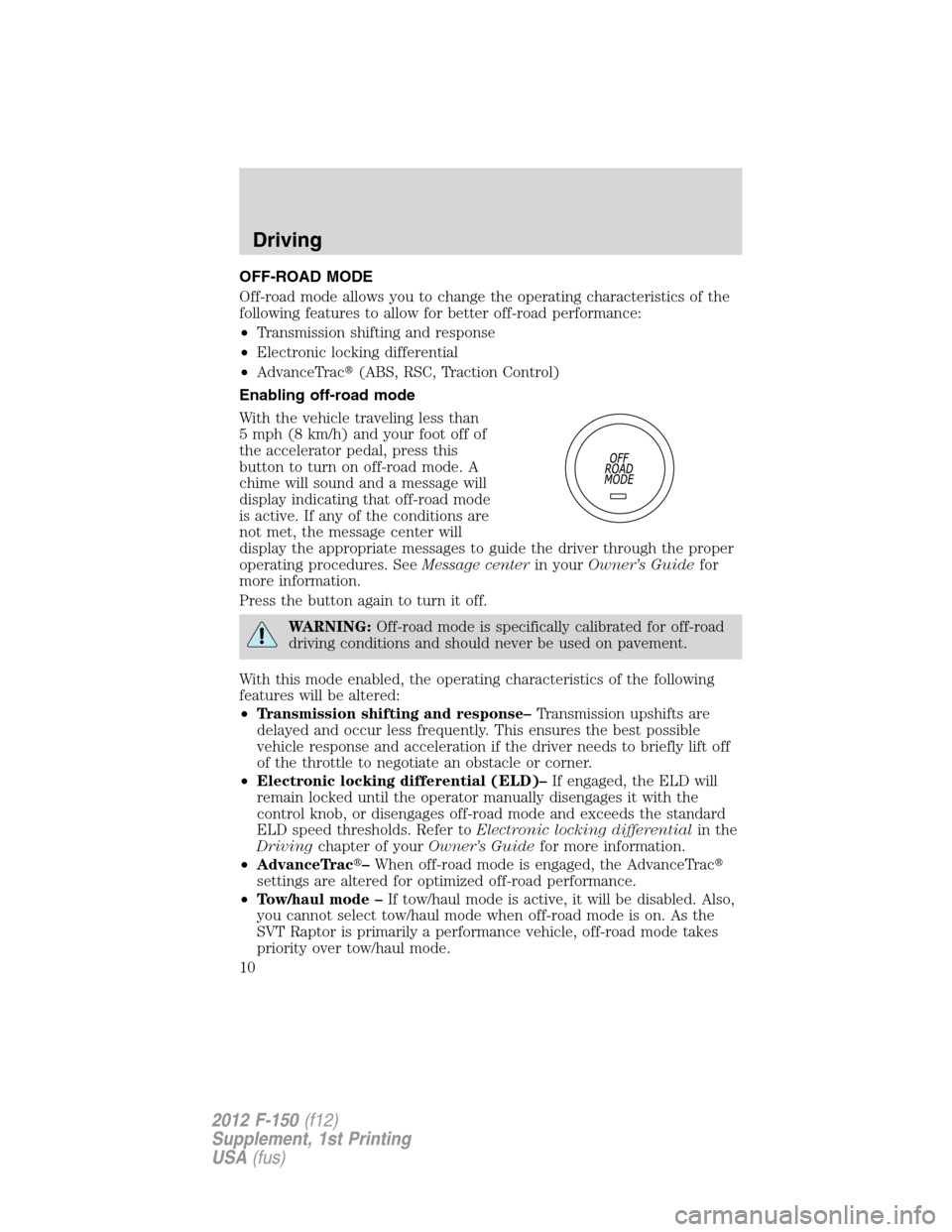Page 10 of 36

OFF-ROAD MODE
Off-road mode allows you to change the operating characteristics of the
following features to allow for better off-road performance:
•Transmission shifting and response
•Electronic locking differential
•AdvanceTrac�(ABS, RSC, Traction Control)
Enabling off-road mode
With the vehicle traveling less than
5 mph (8 km/h) and your foot off of
the accelerator pedal, press this
button to turn on off-road mode. A
chime will sound and a message will
display indicating that off-road mode
is active. If any of the conditions are
not met, the message center will
display the appropriate messages to guide the driver through the proper
operating procedures. SeeMessage centerin yourOwner’s Guidefor
more information.
Press the button again to turn it off.
WARNING:Off-road mode is specifically calibrated for off-road
driving conditions and should never be used on pavement.
With this mode enabled, the operating characteristics of the following
features will be altered:
•Transmission shifting and response–Transmission upshifts are
delayed and occur less frequently. This ensures the best possible
vehicle response and acceleration if the driver needs to briefly lift off
of the throttle to negotiate an obstacle or corner.
•Electronic locking differential (ELD)–If engaged, the ELD will
remain locked until the operator manually disengages it with the
control knob, or disengages off-road mode and exceeds the standard
ELD speed thresholds. Refer toElectronic locking differentialin the
Drivingchapter of yourOwner’s Guidefor more information.
•AdvanceTrac�–When off-road mode is engaged, the AdvanceTrac�
settings are altered for optimized off-road performance.
•Tow/haul mode –If tow/haul mode is active, it will be disabled. Also,
you cannot select tow/haul mode when off-road mode is on. As the
SVT Raptor is primarily a performance vehicle, off-road mode takes
priority over tow/haul mode.
Driving
10
2012 F-150(f12)
Supplement, 1st Printing
USA(fus)
Page 19 of 36

WARNING:Off-roading can be extremely dangerous and carries
inherent risks that may not be preventable even with the best
precautions. Ford strongly recommends driving within your ability and
taking every safety precaution, including those found here and at other
off-road driving organizations such as the Best in the Desert Racing
(www.bitd.com) and SCORE International Off-Road Racing.
Off-road screen
The real-time status of the Raptor’s off-road systems can be continuously
monitored using the first off-road screen found under the Truck Apps
menu in the message center.
SeeMessage centerin theInstrument Clusterchapter of your Owner’s
Guide for more information.
Basic off-road driving techniques
•Grip the steering wheel with thumbs on the outside of the rim. This
will reduce the risk of injury due to abrupt steering wheel motions
that occur when negotiating rough terrain. Do not grip the steering
wheel with thumbs inside the rim.
•Throttle, brake and steering inputs should be made in a smooth and
controlled manner. Sudden inputs to the controls can cause loss of
traction or “upset” the vehicle, especially while on sloped terrain or
while crossing obstacles such as rocks or logs.
•Look ahead on your route noting upcoming obstacles, surface texture
or color changes or any other factors which may indicate a change in
available traction, and adjust the vehicle speed and route accordingly.
During pre-run, mark obstacles with GPS markers to ensure
appropriate speeds are used to avoid potential vehicle damage.
•When driving off-road, if the front or rear suspension is bottoming-out
and/or excessive contact with the skid-plates is encountered, reduce
vehicle speed to avoid potential damage to the vehicle.
•When running with other vehicles, it is recommended that
communication is used, and the lead vehicle notify other vehicles of
obstacles that could cause potential vehicle damage.
•Always keep available ground clearance in mind and pick a route that
minimizes the risk of catching the underside of the vehicle on an
obstacle.
Driving
19
2012 F-150(f12)
Supplement, 1st Printing
USA(fus)
Page 20 of 36

•When negotiating low speed obstacles, applying light brake pressure in
conjunction with the throttle will help prevent the vehicle from jerking
and will allow you to negotiate the obstacle in a more controlled
manner. Using 4L will also help with this.
•Use and equip supplemental safety equipment as discussed later in
this chapter.
•Please consult your local off-road group for other helpful tips.
•Off-roading requires a high degree of concentration. Even if your local
law does not prohibit alcohol use while driving off-road, Ford strongly
recommends against drinking if you plan to off-road.
Driving in mud
•Deep mud should be approached with caution especially if you are
driving in an unfamiliar area.
•If possible, test the depth of a mud hole before entering with the
vehicle.
•Keep in mind that obstacles and deep ruts may be hidden beneath the
surface of the mud.
•Proceed in a steady, controlled manner through deep mud while
maintaining momentum.
•If momentum is lost and you feel the vehicle becoming stuck, turning
the steering wheel back and forth (“sawing the wheel”)
1�4turn in
each direction may give the traction you need to clear the muddy
area.
•In higher speed areas with shallow mud, directional control will be
reduced in the muddy area much like on snow or ice. When
approaching such an area, be sure to slow to a speed which allows you
to maneuver as required by the conditions.
Driving in sand
WARNING:Tires must be returned to normal recommended tire
pressures before driving on pavement or hard surfaces. Failure
to properly maintain your tire pressure could increase the risk of tire
failure, loss of control, vehicle rollover and personal injury.
Driving
20
2012 F-150(f12)
Supplement, 1st Printing
USA(fus)